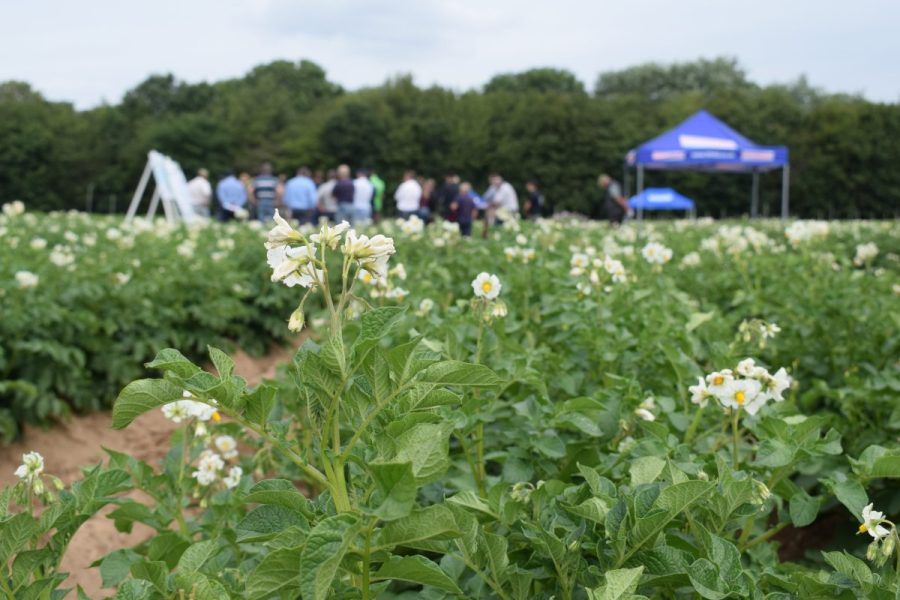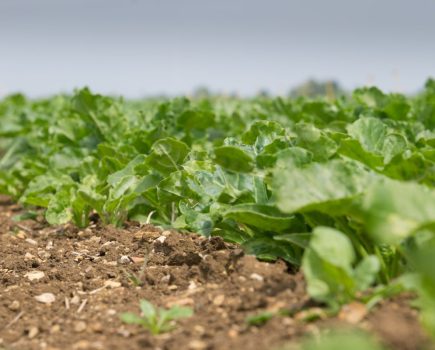Fast becoming the realm of specialist root crop growers, there’s much to consider when it comes to producing a profitable potato crop. CPM attended Hutchinsons’ potato trial open day in Spalding to hear the latest advice on overcoming current challenges.
“It’s not a thought process we should apply just because we’re about to plant potatoes.” DICK NEALE
By Janine Adamson
The ever-constant threat of potato cyst nematode, dwindling chemistry to combat late blight, a blinkered market perception regarding varieties, and now the looming menace that is leaf hoppers. Based on those mere challenges alone, successfully managing a potato crop in the UK appears to be a fine art.
Despite this, a recent open day at Worth Farms in Spalding took a more positive spin on the situation, focussing on what can be done, rather than what can’t.
To set the scene, Hutchinsons’ Dick Neale discussed the actions growers can take to alleviate potential issues in soils while growing a potato crop, as well as before and after. “I often hear comments from root crop growers suggesting little can be done regarding soils due to the nature of the crop.
“But the point is, if soils can be made more resilient – whether that’s to challenging weather, insect pests or weeds – we can help to prepare for a crop like potatoes, and then repair it again afterwards,” he said.
To reiterate, Dick stressed that rather than in isolation, resilience is required throughout the cropping rotation. “It’s not a thought process we should apply just because we’re about to plant potatoes, given they’re one of the most over-cultivated crops we grow.”
Acknowledging that much potato land in the UK is rented, he suggested difficult conversations might have to be instigated. “Following recent weather extremes, we can’t ignore this. We have to make landowners interested or we’ll be backed into a corner whether that’s a pest or weed issue, or simply being able to manage the soil effectively.”
One solution, he believes, is to plant cover crops throughout the rotation, particularly prior to potatoes. However, growers should think carefully regarding what species this includes.
“Here at Worth Farms, MaxiVeg cover crop mix is being used, which is ideal for veg growers as it doesn’t contain brassicas. A blend of five species, it has a low percentage of buckwheat, which is important when sowing early as buckwheat can easily dominate.”
Dick pointed out that for growers with veg-heavy rotations, they could consider selecting a cover crop mix featuring cereals such as oats, wheat or barley. “A cover crop doesn’t necessarily have to be flash, it just has to be diverse compared with what’s being grown as the cash crop. Think about those root masses and behaviours when selecting which cover crop to grow.”
Then, it’s time to make observations, he commented. “Whatever you do, don’t select a cover crop mix, find it doesn’t work because it wasn’t quite the right blend, and then decide cover crops don’t work full stop. It will be the particular species, timing or circumstance which has hindered.”
Another soil-related factor to consider, is earthworm abundance, pointed out Dick. “Of course, nematicide use and a lot of cultivations aren’t helpful, but deep-burrowing anecic earthworms provide effective drainage channels to help plant roots to access moisture and nutrition.
“The way to address this is thinking about how we can help earthworms to survive throughout the rotation.”
One way to achieve this could be to establish cover crops using shallower cultivations, he suggested. “Dig to see if there are any areas of compaction, and if you don’t necessarily have to go to full depth for that cultivation, ask whether you should?
“Equally, while the focus is growing a subsequent bulk of tubers, those tubers are situated often no more than 20cm deep in the baulk, with the plant roots extending deeper into soil below that.
“So, do I have to cultivate so deeply if my soils are ok? Less is more; a shallower cultivation will help to preserve the cover crop roots at depth, retaining those benefits while successfully producing the potato crop,” explained Dick.
For something different, Hutchinsons has been looking at the rooting behaviour of three high-yielding wheat varieties grown both in isolation and as a blend. “As straights, we can see their roots are concentrated in the upper part of the soil profile.
“But if you really want to make things different – if your break crop in a veg rotation is a hard Group 4 winter wheat – you want to grow a blend. You achieve much more diverse rooting behaviour right through the profile,” he said.
For those looking for an alternative perspective on inputs, head of crop nutrition, Tim Kerr, explained that Hutchinsons is trialling two N-fixing biological products – BlueN and Vixeran.
“BlueN fixes nitrogen from the air by colonising through the leaf. The idea is, it fixes around 3kgN/ha/week, up to around 30kgN/ha throughout the season,” he said. “There has been some successful work undertaken in potatoes when using BlueN as an addition to nitrogen, but, I think perhaps more interesting, would be its use to substitute a quantity of nitrogen.”
Vixeran is slightly different, pointed out Tim. “This colonises through the leaf, roots and rhizospheres as a triple-action bacteria to again fix nitrogen, with the potential of replacing up to 30kgN/ha in the programme.”
However this year, the Hutchinsons trial is investigating whether these two products can add yield, rather than replace conventional nitrogen. Having conducted assessments for a few years, Tim said the results so far are promising.
“Both products appear to give more resilience, particularly in dry seasons where they’re fixing N consistently, irrespective of the climatic conditions. Potentially, due to its triple action, Vixeran could be more consistent – but that’s the problem, achieving a consistent response.”
A product that Tim believes has a lot of potential, is SuperFifty Prime – a concentrated Ascophyllum nodosum seaweed-based biostimulant from BioAtlantis. With a formulation that comprises 50% of the extract, this makes the biostimulant the most concentrated of its type on the market, said Tim.
“It’s used to prime the plant to cope with oxidative stress, inducing tolerance to various adverse weather conditions. We’ve seen some positive results and it appears to be very effective.”
Michael Rodger of Richard Austin Agriculture has also been involved in the trial. He commented: “Potatoes seem to be one of the most responsive crops. However, as with any stress-reducing, priming product, timing is key – you have to be ahead of the stress period.”
In agreement, Tim added that SuperFifty Prime should be applied 3-5 days advance of the stress, with temperatures at least 10oC on the day of application. “Using the recommended two applications at 2.0 l/ha, we’ve seen a 4t/ha response in potatoes,” he concluded.
This article was taken from the latest issue of CPM. Read the article in full here.
For more articles like this, subscribe here.
Sign up for Crop Production Magazine’s FREE e-newsletter here.




